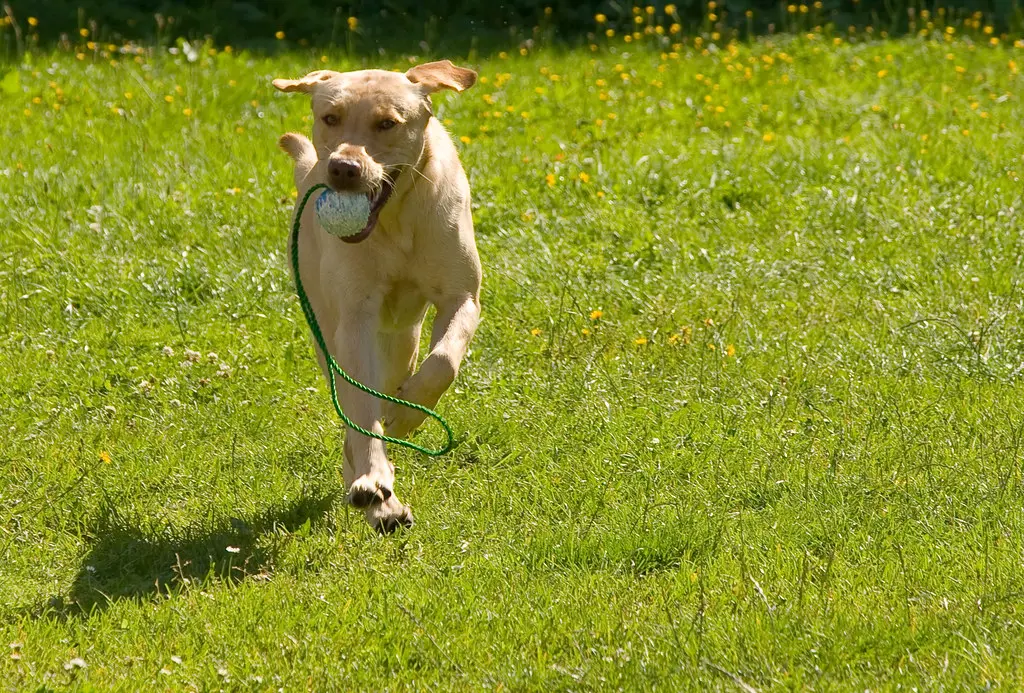Labrador Retrievers are one of the most popular dog breeds worldwide, often topping the charts in countries like the United States, United Kingdom, and Canada. They are known for their friendly and playful demeanor and are considered excellent pets and working dogs alike. In this article, we’ll discuss Labrador Retrievers as pets, including their behavior, temperament, diet, and other essential information to give potential owners a comprehensive understanding of this lovable breed.
 About This Specie
About This Specie
Family: Canidae
Class: Mammalia
Length: 22.5 – 24.5 inches (Male) and 21.5 – 23.5 inches (female)
Lifespan: Average of 10 years, can live up to 12
Weight: 65-80 pounds (Male) and 55-70 pounds (female)
Energy Level: High
Quick History
Labrador Retrievers originated in Newfoundland, Canada, where they were bred to be working dogs for fishermen by retrieving nets and fish. The breed was later refined in England and has since become a popular choice for families, hunters, and as service animals due to their intelligence and easy-going nature.
Appearance and Size
Labradors are medium to large-sized dogs with a muscular, balanced build. Their short, dense coat comes in three classic colors: black, yellow, and chocolate. They have a broad head, friendly eyes, and a distinctive “otter” tail that helps them swim.
- Male Labradors typically weigh between 65-80 pounds, while females range from 55-70 pounds.
- Labradors usually stand 21.5-24.5 inches at the shoulder.
Behavior and Temperament
Labrador Retrievers have an affectionate, cheerful and energetic temperament. They love being around people and thrive in families with children. Labs are playful by nature but also have a calm, even-tempered side. They need regular exercise to burn off their high energy levels as well as mental stimulation through games, training and activities. Labs tend to be loyal, affectionate and gentle with their owners but they can also be possessive of food, toys and people within their “pack.” Early socialization is important so that Labs grow up to be well-adjusted, friendly dogs.
Socialization
Labrador Retrievers are inherently social dogs and are known for their tender interaction with humans, including children, and other animals. This stems from their original role as working dogs with fisherman, where collaboration and sociability were key. It’s also what makes them exceptional service animals today.
Eagerness to Please
Another distinctive Labrador Retriever temperament is their eagerness to please. This trait translates into high trainability. Labradors are often easy to train and excel in obedience training, which is a testament to their intelligence and desire to make their owner’s happy.
Activity Level

Labradors are active and playful dogs. They come from a lineage of working dogs and have maintained their need for exercise and physical activity. Owners should bear this in mind as insufficient physical stimulation can lead to boredom and potentially destructive behavior. Regular walks, play sessions, and mental stimulation through training can help keep a Labrador Retriever happy.
Adaptability
Labradors are highly adaptable. Their friendly and easy-going nature allows them to feel at home in a wide variety of environments. Whether living in the city or the countryside, as long as their exercise and social needs are met, they’ll likely adapt with ease.
While these are general behavioral traits commonly observed in Labrador Retrievers, it’s important to remember that each dog is unique. A dog’s behavior and temperament will always be influenced by numerous factors, including their genetic background, early life experience, training, and socialization.
Diet and Feeding

A Labrador Retriever’s diet should provide them with the right amounts of essential nutrients including proteins, carbohydrates, fats, vitamins, minerals, and water. The food they consume should be nutrient-packed, providing them with the energy, strength and support needed for their active lifestyle.
Choosing the Right Food
Selecting high-quality, nutritious dog food plays a crucial role in a Labrador’s health. Consider these factors when choosing an appropriate food:
- Quality: Look for dog food that meets the Association of American Feed Control Officials (AAFCO) standards for complete and balanced nutrition.
- Life Stage: Choose a formula tailored to your Labrador’s specific life stage (puppy, adult, or senior).
- Activity Level: Active Labradors might require a more calorie-dense, high-protein diet, while more sedentary dogs might benefit from a weight management formula.
Feeding Schedule
Determining the correct feeding schedule can help ensure your Labrador is receiving adequate nutrients without overeating:
- Puppies: Labrador puppies should be fed multiple small meals throughout the day to cater to their growing bodies and high energy levels. As a general guideline, feed them four times daily until they’re four months old, reducing to three meals a day until they reach six months, followed by two meals from six months onwards.
- Adults: Adult Labradors should ideally be fed twice daily – once in the morning and once in the evening. This can help maintain an even distribution of energy levels, promote healthy digestion, and discourage overeating.
Portion Control
Overfeeding can be detrimental to a Labrador’s health, leading to obesity and related health issues. Take these steps to ensure appropriate portion sizes:
- Read the Label: Follow the manufacturer’s recommended serving size based on your Labrador’s weight. This is a good starting point, and adjustments can be made depending on individual activity levels and metabolism.
- Monitor Weight: Regularly weigh your Labrador and consult with your vet to ensure they are maintaining a healthy weight. Adjust food portions as necessary.
Tips for a Healthy Diet
- Treats in Moderation: Treats are often high in calories and should be given sparingly, making up no more than 10% of your Labrador’s daily caloric intake.
- Avoid Table Scraps: Human food can be high in fat, salt, and sugar, which can lead to obesity and health issues for your Labrador. Refrain from feeding table scraps and stick to a balanced dog diet.
- Consult Your Vet: Your veterinarian can offer personalized guidance on choosing the most suitable diet for your Labrador, considering factors like age, weight, and any existing health issues.
Training and Exercise
Proper training can shape your Labrador’s behavior, strengthen your bond, and keep their health in a good state. Here are some key aspects to consider when training your Labrador:
Start Early
The sooner you start training your Labrador, the better. Early training makes a crucial difference in how a puppy grows up. Beginning at a young age ensures they learn proper behavior and reduces the likelihood of problematic habits later in life.
Positive Reinforcement
Labradors respond well to positive reinforcement training methods. Use treats, praise, or toys as rewards for desired behavior. This encourages your Lab to repeat these behaviors while building a positive association with the training process.
Consistency is Key
Be consistent with your training commands and rules. Consistency helps your Labrador understand what you want from them and promotes successful learning.
Socialization
Expose your Labrador puppy to a variety of environments, people, and other animals to enhance their social skills and prevent fear or aggression problems in the future.
Exercise
Physical activity is paramount for a Labrador’s overall health and happiness. Here are some exercise guidelines to keep in mind:
Regular Exercise
Labradors are athletic and energetic dogs that thrive on regular exercise. Aim for a minimum of one hour of exercise per day, which can be split into two or more sessions.
Engage in Different Activities
Diversify your Labrador’s exercise routine. This could include activities such as walking, running, swimming, fetching, agility training, or participating in dog sports. This ensures that they get a mix of both mental and physical stimulation.
Provide Mental Stimulation
Just like humans, dogs need mental exercise too. Use puzzle toys, hide-and-seek games, or training sessions to keep your Labrador’s brain active. This can help prevent boredom and promote overall well-being.
Health and Lifespan

As with any breed, ensuring proper care and attention is essential for promoting good health and maximizing their lifespan. On average, a healthy Labrador Retriever will live between 10 and 14 years.
Genetics and Inherited Conditions
Labradors can be predisposed to specific genetic conditions that may affect their health and lifespan. Some of these inherited conditions include:
- Hip dysplasia
- Elbow dysplasia
- Progressive Retinal Atrophy (PRA)
- Exercise-Induced Collapse (EIC)
- Hereditary Myopathy
Choose a reputable breeder who screens and tests their breeding dogs for these conditions, and always review the health clearances of both parents to minimize the risk of inherited health issues in your Labrador.
Common Health Issues in Labradors
Labradors, like any breed, can be prone to certain health issues. Some common health concerns for Labradors include:
- Obesity – predisposed due to their hearty appetite
- Ear infections – due to their floppy ears
- Allergies – environmental or food-related
Becoming familiar with these issues and signs to look for can help you address any concerns promptly, ensuring proper care and treatment.
Importance of Regular Check-ups and Vaccinations
Make sure to schedule regular veterinary check-ups for your Labrador, usually at least once a year. These check-ups can help identify underlying health issues early, allowing for prompt intervention and improved outcomes. Additionally, keeping your Labrador up-to-date on vaccinations is crucial for preventing serious illnesses such as parvovirus, distemper, and rabies.
Grooming and Care

Grooming your Labrador not only makes them look clean and appealing but also provides an opportunity for health checks and bonding. This guide will help you understand the essentials of grooming and caring for Labrador Retrievers.
Coat and Skin Care: The Basics
Labradors are known for their double-layered, water-resistant coat that helps insulate them in different weather conditions. The coat requires regular brushing, especially during seasonal shedding periods. Remember, their skin is sensitive, so using the right tools and gentleness during brushing is critical.
Essential Grooming Tools for Labradors
High-quality, suitable tools make the grooming process easier and more effective. Essentials include a good-quality slicker brush or undercoat rake for removing loose hair, appropriately-sized nail clippers, a canine toothbrush and toothpaste, and gentle, dog-approved shampoo.
Bathing: How Often and What to Use
Labradors generally remain clean and don’t require frequent baths unless they get into something dirty or smelly. Bathing them too frequently can strip their skin of natural oils and cause dryness. When bathing, choose a gentle, dog-specific shampoo that suits their skin type.
Ear Care: Prevent Infection
Labrador Retrievers have floppy ears that can trap moisture and dirt, leading to infections. Regular cleaning with safe ear cleaning solutions and gentle ear wipes can help prevent these common ear problems.
Teeth Cleaning
Dental hygiene plays an essential part in overall health. Brush your Labrador’s teeth regularly with dog-friendly toothpaste to prevent plaque build-up and subsequent tooth decay and gum disease. Dental treats can supplement but not replace regular teeth brushing.
Nail Trimming
Long nails can cause discomfort and lead to problems with walking and posture. Trim your Labrador’s nails regularly using a suitable nail clipper or grinder. If unsure about doing this yourself, seek help from a professional groomer or vet.
Pros and Cons of Owning a Labrador Retriever

There are many positive aspects of owning a Labrador Retriever. They are as follows:
1. Friendly and Affectionate
Labradors are well-known for their outgoing, friendly demeanor and their love for human companionship, making them an ideal family pet.
2. Intelligent and Trainable
Labradors are bred for intelligence, making them highly trainable. They excel at obedience training and learn commands quickly, which contributes to their widespread success as service animals.
3. Energetic and Playful
Labradors are high-energy dogs that love to play and exercise. This can be a great motivator for owners to remain physically active and engaged with their pet.
4. Good with Kids and Other Pets
Labradors are generally kind and gentle with both kids and other pets, making them a suitable breed for households with children and other animals.
5. Adaptable
Labradors are adaptable and can thrive in a variety of environments, from urban settings to rural landscapes. They also cope well with varying weather conditions due to their double-layered coat.
Cons of Owning
While there are many benefits of owning a Labrador, they come with their challenges as well:
1. Need for Regular Exercise
Labradors require consistent physical activity to maintain their health, which may not be suitable for those with a sedentary lifestyle or limited time to commit to exercise.
2. Shedding
Labradors have a double-layered coat that sheds moderately throughout the year, with higher shedding during seasonal changes. This requires consistent grooming and may not be ideal for those with allergies or a dislike for pet hair.
3. Potential Health Issues
Like any breed, Labradors are prone to certain health issues, such as hip dysplasia, obesity, and ear infections, which can contribute to ongoing medical expenses and care.
4. High Food Motivation and Tendency for Obesity
Labradors are known for their hearty appetite, which may lead to overeating and subsequent obesity if not monitored and controlled.
5. Size and Strength
Labradors are a medium-large breed with a muscular build, which can be challenging for some people to handle, especially if the dog is not well-trained.
Assessing Whether a Labrador is the Right Dog for You
Before adopting a Labrador Retriever, consider your lifestyle, living situation, and the level of commitment you can invest in a pet. Assess your ability to provide a Labrador with the necessary physical activity, mental stimulation, grooming, and medical care they require.
Conclusion
Labrador Retrievers are a loving, intelligent, and adaptable breed that can make wonderful companions for many families. However, they come with their unique challenges and needs, which potential owners should consider before adopting. By understanding the pros and cons of owning a Labrador Retriever, you can make an informed decision and determine if this breed is the best fit for your lifestyle and home.
Labrador Retrievers, with their affectionate, friendly demeanor, do indeed make fantastic pets. However, potential owners should be prepared for their energetic nature and be ready to invest time and effort into training, exercise, and care to ensure a happy and healthy life for their lovable companion.
